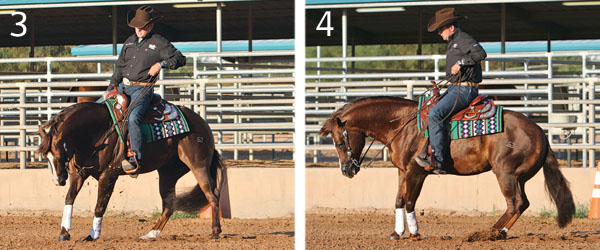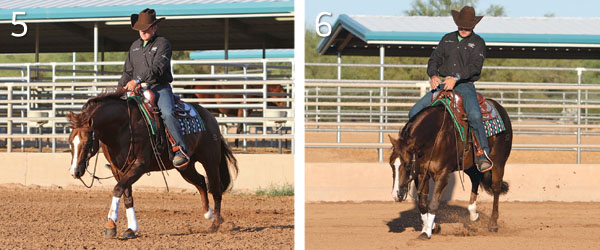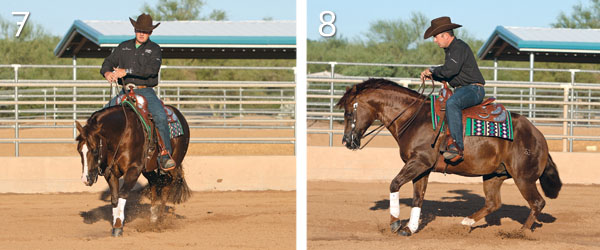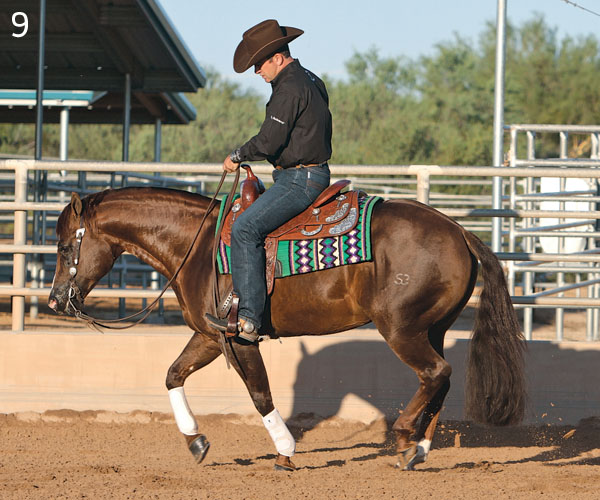Just like every maneuver, good circling requires a solid foundation of training, especially in a horse’s steering. With a reliable steering framework, a horse can quickly pick up precise circling. But if a horse doesn’t have a thorough understanding of following the rider’s hands and subtle cues from the bit, he won’t circle well. It takes much longer to reteach a horse with holes in his foundation than it does to give him reliable basics to begin with.
For this lesson, I’ll assume that your horse has solid basics in his guiding and circling training, but needs to hone those skills because he’s started leaning or drifting in his circles. I’ll show you the steps for two exercises to work on his shortcomings. I suggest riding one-handed in the bit you’d show in. This allows your horse to learn from the correction in his normal riding headgear. You can ride two-handed as needed.
1. For both of these exercises, I begin by testing my horse’s “guide.” As we lope on a large circle, I give him his face and see where his mind is focused. If it’s on me, he’ll continue loping along the circle correctly, and I won’t school him. We’ll lope a few nice circles and call it good. But, if he doesn’t listen to my hand or if he’s leaning, I’ll correct him. For this lesson, we’ll start with his ignoring my hand, and then move on to leaning in his circles.

2. As I guide my horse around my circle, I test him to see the path he chooses. He started to go off track as I came around my circle, so I tried to quietly correct him by moving my hand 2 or 3 inches across his neck. But he ignored my hand cue, so I initiate an overcorrection. I lift my rein hand up and bring it back toward my hip to oversteer my horse in the direction I wanted him to travel.
3. I bring my horse down to a very small circle in the same direction we were traveling when he ignored my steering cues. Loping a tight circle that winds down into spins is much more work than guiding the way he’s trained to respond.

4. I wind into smaller circles, until I’m turning my horse on his hindquarters and then spinning in the direction of travel. I use my outside leg to move his shoulders to the left for the spin and encourage him to stop leaning on my neck rein (right rein). I spin him until he no longer pushes against my neck rein. It might take one turn, or it might take six—we keep turning until I get the response I’m looking for.
5. I then quietly lope my horse off in the same direction we were traveling and on a loose rein. I give him the benefit of the doubt that he’ll stay on the path and listen to my rein cues going forward. If he doesn’t, then I’ll repeat the process outlined in Photos 1 through 4. If it continues to be a problem, then I’ll go back to basic steering training in a snaffle to ensure that there aren’t any holes in his neck-reining education.

6. Leaning is another common problem when circling. It can be leaning toward the gate or another spot in the arena. The key is to let your horse make the mistake, make him work for the mistake, and then go back to riding. In this case, my horse is leaning to the inside of the circle. I’ll let him go on like this for two to three strides—giving him enough time to fix himself—and then I’ll put him through his paces.
7. After giving my horse a chance to correct himself, I change to riding two-handed for better leverage and pull him into the ground (pull him to a stop without saying “whoa”). This stops his forward motion and brings his attention to me, rather than what he was drifting or leaning toward.

8. I quickly turn him opposite the direction he was leaning—to the right, in this case—four or five times. Just like with my guide correction, this is a lot more work than staying square and focusing his mind on the task at hand. I want my horse to think on his own and use his brain to know where he needs to be. A solid training foundation allows him to have confidence that he knows what to do.
9. After completing the quick turns, I put my horse back on the circling path, ask for a lope, and give my horse another chance to do it correctly. It’s a matter of forgive and forget—you can’t hold a grudge, or you and your horse will grow to resent the process. If you ever get to a sticking point, go back to basics to ensure that there aren’t any missing links in his training.

Andrea Fappani, Scottsdale, Arizona, has won every major National Reining Horse Association event, was a member of the gold-medal winning U.S. reining team at the 2014 World Equestrian Games, and is an NRHA $4 Million Rider. In addition to showing Quarter Horse and Paint reiners, Fappani has also had success competing with Arabian and Half-Arabian reining horses. Learn more at fappaniperformance.com.






